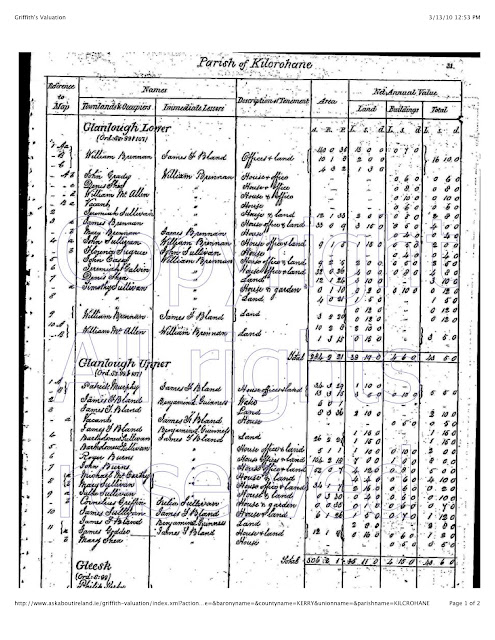 |
| One of Aunt Nellie Keohane's pictures - not sure exactly where it was taken |
A little more background so we have an idea of what was happening "back in the day."
In the previous letter, Mr.
Stokely mentions the General Valuation of Ireland carried
out in the 1850s. The British Government wanted to impose a countrywide tax so Richard Griffith was commissioned to conduct a valuation of all the
property in Ireland. To ensure accuracy, Griffith wrote out detailed
instructions for his workers and let them know that - if he found anything
lacking - their services would be terminated.
James R. Reilly writes in his
article “Is There More in Griffith’s Valuation Than Just Names?” that before
the valuation could be carried out, “the boundaries of every county, barony,
civil parish, and townland in Ireland had to be scientifically surveyed and
maps drawn.” The British Army Corps of Engineers carried out the survey of the
land and made the maps. The numbers on the maps for each townland
correspond with numbers listed in Griffith’s Valuation. Therefore, if we can obtain the maps, we should be able to identify where each townland – and
homestead - was and is located.
 |
| Example of what a page from Griffith's Valuation looks like. |
This is a page from Griffith's Valuation of Kilcrohane Parish. I know it is difficult to read here, but this shows the valuation of a townland which will be important to our story - Glanlough Lower which contains Loughane - where Ma was born.
The first column on the left gives the numbers that correspond to the numbers on the Valuation map as James Reilly mentioned above.
The second column gives the name of the townland and the names of the tenants in that townland. This is where we will find our relatives.
The third column gives the name of the lessors - the person to whom the rent is paid. What can be surprising is that it is not always the landlord collecting the rent! In one case here in Glenlough Lower, William Brennan is renting some land from the local landlord James F. Bland. But William then rents out some of his holding to others who pay rent to him. In our case this column will tell us to whom our relatives paid rent.
The 4th column will describe the "tenement" or what kind of holding our relatives are renting - house, office which is a farm building, and/or land. Sometimes just land was rented or just a house and garden.
The 5th column gives the area in acres, roods, and perches.
Reilly writes “The holder of less than five acres was labeled a 'cottier or
laborer'; small farmers usually held between five and thirty acres, and
the large farmer occupied more than thirty acres … Prior to the Great Famine, a
farmer saw little harm in subdividing a rented holding to ensure the economic
well being of each son as he married; and in some cases, even the sons-in-law
received as dowries of their brides some share of the farm.”
Imagine you have a
holding, and then you give parts of it to your sons or sons-in-law so that they will have a place to live and some land. The Irish had large families in those days. Your holding
gets smaller and smaller. There are more and more people living on what was the the
original holding. This is what happened in the Great Hunger or the Famine - more and more people were living on smaller and smaller holdings - potatoes were the basic food - and sometimes the only food. When the blight struck those potatoes .... disaster. Many people had nothing else.
The last column gives the value of the land, then the value of the buildings, and finally the total of both which is the rent that is paid.
Reilly
goes on to explain that the tax on the buildings was an estimate of the annual rent a landlord could expect from a tenant. “Construction materials,
age, state of repair, and dimensions of the house or office were the factors
used to determine taxable value. A house built of stone and brick in perfect
repair with a slated roof is rated at a higher value than one constructed with
mud walls roofed with thatch. The house of mud walls, thatched roof and
needing repair is still rated higher than the dilapidated, scarcely habitable
structure euphemistically called a cottage.”
I imagine my relatives were living in a house with mud walls and a thatched roof - I hope they weren't in a dilapidated cottage.
So if Ma was born in Loughane, how come there aren't any Moriartys listed in this valuation of Glenlough Lower?
No comments:
Post a Comment